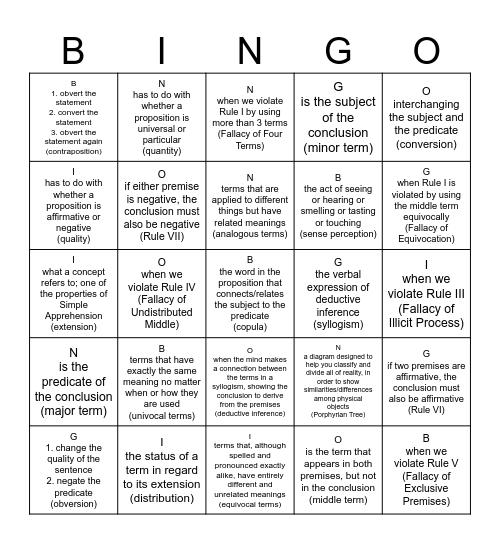

This bingo card has 25 words: B terms that have exactly the same meaning no matter when or how they are used (univocal terms), I terms that, although spelled and pronounced exactly alike, have entirely different and unrelated meanings (equivocal terms), N terms that are applied to different things but have related meanings (analogous terms), G 1. change the quality of the sentence 2. negate the predicate (obversion), O interchanging the subject and the predicate (conversion), B 1. obvert the statement 2. convert the statement 3. obvert the statement again (contraposition), I has to do with whether a proposition is affirmative or negative (quality), N has to do with whether a proposition is universal or particular (quantity), G the verbal expression of deductive inference (syllogism), O when the mind makes a connection between the terms in a syllogism, showing the conclusion to derive from the premises (deductive inference), B the act of seeing or hearing or smelling or tasting or touching (sense perception), I what a concept refers to; one of the properties of Simple Apprehension (extension), N a diagram designed to help you classify and divide all of reality, in order to show similarities/differences among physical objects (Porphyrian Tree), G if two premises are affirmative, the conclusion must also be affirmative (Rule VI), O if either premise is negative, the conclusion must also be negative (Rule VII), B when we violate Rule V (Fallacy of Exclusive Premises), I when we violate Rule III (Fallacy of Illicit Process), N when we violate Rule I by using more than 3 terms (Fallacy of Four Terms), G when Rule I is violated by using the middle term equivocally (Fallacy of Equivocation), O when we violate Rule IV (Fallacy of Undistributed Middle), B the word in the proposition that connects/relates the subject to the predicate (copula), I the status of a term in regard to its extension (distribution), N is the predicate of the conclusion (major term), G is the subject of the conclusion (minor term) and O is the term that appears in both premises, but not in the conclusion (middle term).
Traditional Logic Bingo | Traditional Logic Bingo | Rasoning | Traditional Logic Chapters 10-13 | Traditional Logic I Review Bingo
Share this URL with your players:
For more control of your online game, create a clone of this card first.
Learn how to conduct a bingo game.
With players vying for a you'll have to call about __ items before someone wins. There's a __% chance that a lucky player would win after calling __ items.
Tip: If you want your game to last longer (on average), add more unique words/images to it.